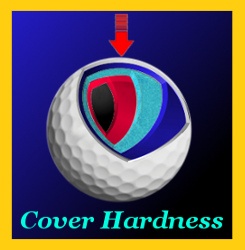
In golf, the term “ball cover hardness” refers to the firmness or softness of the outer cover material of a golf ball. It is a characteristic that affects the feel, spin, and overall performance of the ball.
Golf ball covers are typically made of materials such as urethane or surlyn, each having different hardness levels:
- Soft Cover: Golf balls with softer covers are known for providing a softer feel at impact. Soft covers are often made of urethane, a material that offers excellent control and spin around the greens. The softer cover allows the ball to grip the clubface more effectively, resulting in increased spin and better shot-stopping ability on approach shots and pitches. Soft-covered balls are often preferred by skilled golfers who prioritize control and precision.
- Firm Cover: Golf balls with firmer covers, commonly made of surlyn, have a harder feel at impact. These covers tend to be more durable and resistant to scuffs and cuts, offering greater longevity. Firmer covers may provide a bit less spin and feel compared to softer covers but can generate more distance and durability. Balls with firm covers are often popular among recreational golfers, beginners, and players who prioritize distance and durability over precise shot control.
The choice of cover hardness depends on a golfer's personal preferences, skill level, and playing style. Some golfers prefer the softer feel and enhanced control of a urethane-covered ball, while others may prioritize the durability and distance of a surlyn-covered ball.
It's important to note that cover hardness is just one of many factors that impact a golf ball's overall performance. Other factors such as core construction, compression, and dimple design also influence the ball's flight characteristics, spin rates, and overall playability. Manufacturers continue to develop new cover technologies and materials to optimize performance for different player needs and course conditions.
Ultimately, golfers should experiment with different ball models and cover hardness options to find the one that suits their game and preferences the best.
Cover Hardness of a Golf Ball: Tests measure the amount a golf ball’s surface or cover indents when a constant pressure is applied. The lower the rating, the softer the ball will feel when struck. A higher rating indicates a harder feeling.





